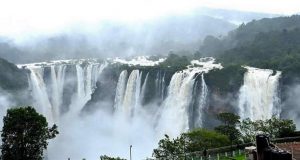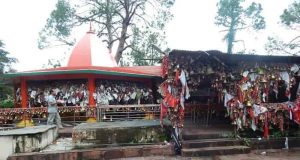List of Popular Fair and Festival (Mela) in Gujarat
Gujarat, a very colorful state has a very rich historic and cultural background. Traditional and cultural richness make the land the ground for many pompous festivities that pull tourists from far and wide. Spirituality too rules supreme in the land of Gujarat and many of the fairs & festivals celebrated here are directly connected to the various temples that dot the state. To know about the fairs and festivals of Gujarat in detail, read on-
Rooted in the Caravans…
Gujjars, a nomadic tribe of ancient times shaped the picturesque land of Gujarat. Historians recognize them as the first settlers of the land. Although over time, there has been a steady inflow of other cultural influences, the culture delineated by the Gujjars is far from being passed.
The lingering impact of Gujarat on Indian history is unfathomable. In the soil of Gujarat culminated the saga of the Indian Freedom Struggle, the art of Gujarat, the colorful attire that people adorn, the soulful music, and the variety of food; all testifying to the rich culture that Gujarat boasts of.
The Flair of the Fairs!
All around the year in Gujarat, there are occasions that allow people to bask in the festive mood. Innumerable fairs are conducted on this land of colors, and some of the major ones are enlisted as under:-
1- Bhavnath Mahadev Mela (February)
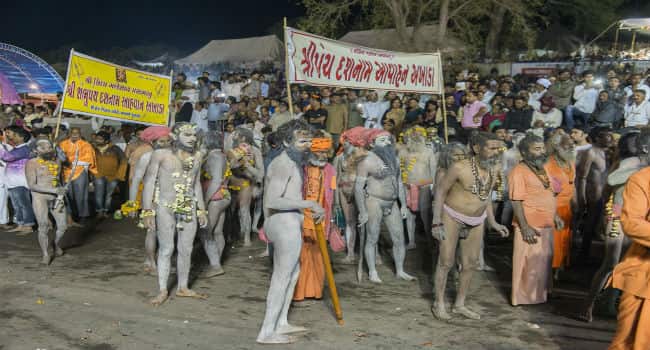
One of the most famous temples of Gujarat is an ancient temple dedicated to Lord Shiva and is universally called the Bhavnath Mahadev temple which is located at the base of Girnar Mountain. Girnar is infamously known to be the abode of the nine Nathas, who are assumed to be immortal, and eighty-four Siddhas or spiritually elevated souls all of whom also visit the temple, in their spiritual bodies. During the month of February when a large section of the nation celebrates the Maha Shivratri festival, the Bhavnath Mahadev Mela is held and it is a five-day-long celebration.
The Hindu belief is that during this period, while the fair is organized, this shrine is visited by Lord Shiva himself. As the prayer ceremony commences, several saints, also known as Naga Babas who live around the vicinity, arrive at the venue on elephants and blow away conches holding flags in their hands. The festival organizers provide free food to all the devotees and tourists during this celebration. These fairs also put up numerous stalls selling religious idols, holy beads, brass and copper utensils brought in from Ayodhya and Mathura, fruits, and sweets. And on the 14th day of the month of Magh, a massive Puja is conducted in this temple known as the Maha Puja, which is the most awaited ceremony of the fair.
2- Chitra –Vichitra Mela (March)
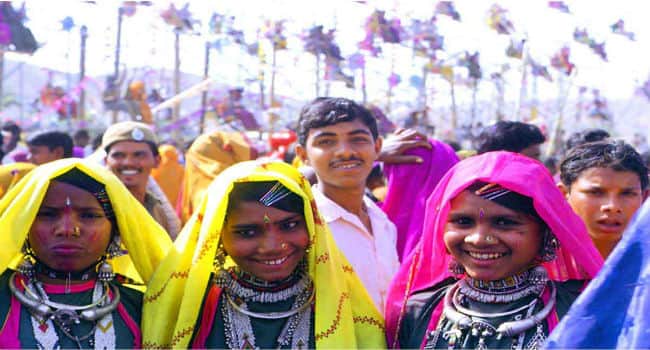
Chitra-Vichitra is one of the largest and most colorful tribal fairs celebrated in Gujarat. It is convened after fifteen days from Holi. And legends suggest that name of this fair comes from Chitravirya and Vichitravirya, the sons of the great Emperor, Shantanu. It was believed that the two princes lived in this place and were miraculously cured of all ailments. The Adivasi tribe of Gunbhakhari village in the district of Sabarkantha organizes this fair each year with great grandeur.
Each year, this fair witnesses around 60,000 to 80,000 tribes who offer some spectacular cultural performances. These people come from distant places in their traditional clothing to take part in this fair and the main tribal sects at the fair are the Bhils and Garasis. The common apparel that is usually donned is blue shirts, white dhotis and a red or orange turban for men. Women wear embroidered and bejeweled long skirts, commonly known as Ghagharas, and are adorned with heavy pieces of silver Jewellery all over their bodies. They often adorn themselves with bright red vermillion. Big drums are brought with them and are kept beating to spiritual, melodic rhythms while the women hum interesting folk songs to entertain the crowd and praise the Lord. And the celebrations do not end until the wee hours of the morning.
The fair has hundreds of food stalls selling sumptuous local delicacies and sweets of a huge variety. Stalls also sell various brass, copper, and silver articles as the fair usually has tourists visiting from all over the world. Such fairs still hold on to the indigenous modes of recreation for children and adults with rides such as the giant wheel, merry-go-round, etc. The ancient temple where the fair is conducted provides a breathtaking sight as it looks into the serenities of the Sabarmati, Vyakul, and Akul rivers.
3- Kutch Mahotsav (February)
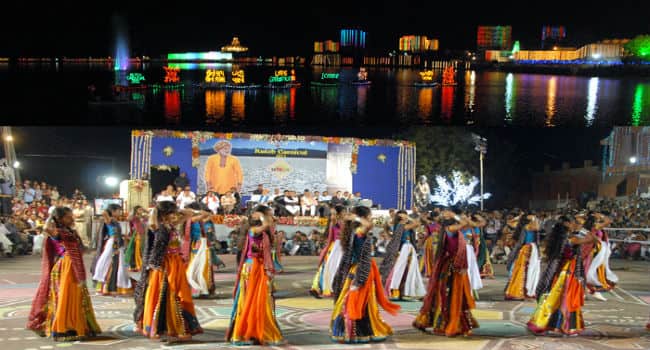
The tourism authorities of Gujarat host an annual fiesta every year in the month of February according to the English calendar. This grand festival not only exhibits various forms of folk dancing, music, poetry, and ballads but also showcases some brilliant handcrafted local products and jewelry from the indigenous artisans. This festival is also a successful attempt in bringing the citizens from all over the state as well as other parts of the country to render a whole fresh articulation to the term “Unity in Diversity” as it thrives on appreciating different forms of art and cultures.
4- Narsinghji Fair (January-February)
The Narsinghji Fair takes place in Gomtipur in the Ahmedabad district of Gujarat. This fair usually commences in the month of January or February and is spread across four days. The nature of this fair is rather unique as it is an amalgamation of both spiritual and religious beliefs. It provides secular recreation or entertainment in the form of stalls, children’s rides, and cultural programs and it is religious since it has a long history! The Narsinghji fair is a complete entertainment package for anyone who decides to visit both travelers and local dwellers. Music performances, dance programs, and many other artistic performances are displayed by artists who come from across the country. One is most likely to find a large number of stalls and shops to purchase little things for their near & dear ones.
5- Dhrang Fair (February-March)
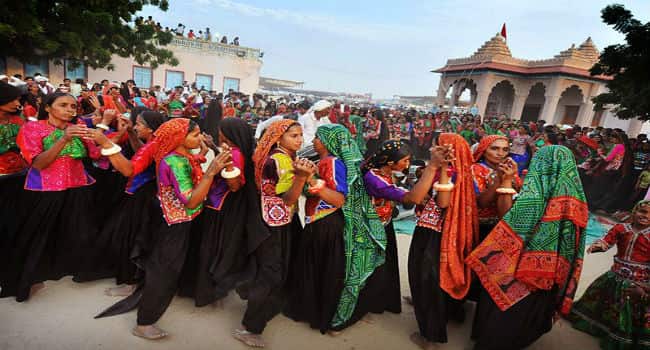
This fair was initially organized to commemorate a great saint and social worker named Mekaran Dada of the 17th century. It was believed that he used to provide food and water while guiding travelers the route of the desert and lived along with his pet dog and a donkey. Other than the history, the fair also has ample entertainment to offer. During also puts up stalls of handicrafts that are world-famous.
6- Madhavpur Fair (April)
Madhavpur (Ghed) is a small, culturally significant village situated in Gujarat. It geographically lies on the seashore, close to Porbandar. It’s believed that Lord Krishna had come to this village after abducting Rukmini, after which they were married. This fair is celebrated in the memory of that incident and a temple was also built for the Lord Madhav Rai. Through this, the local villagers organize a beautiful cultural fiesta in celebration of colors, art, and religion.
7- Rath Yatra (July)
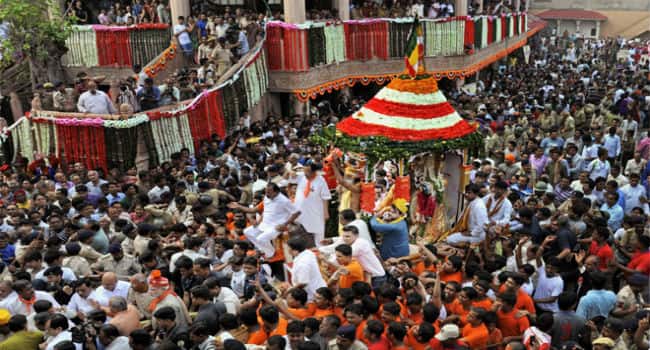
Rath Yatra is a huge festival celebrated in Gujarat. The words ‘Rath’ signifies ‘chariot’ and ‘Yatra’ means ‘journey’. And as the name suggests, an enormous wooden chariot is prepared and the murals of Lord Krishna, Lord Balaram, and Goddess Subhadra are placed in them. Just like the other festivals, this too has folklore related to the commencement of the festival and according to the Bhagavata Purana, Lord Krishna’s maternal uncle Kansa was sent to Akrur to bring the Lord and his elder brother Balram, to Mathura from Gokul.
While all of them were ready to leave for Mathura, the Gopis and Gopals blocked the way of their chariot. After requesting, they bid him farewell. Since that day, the Festival of Rath Yatra is celebrated in the memory of the overwhelming separation. And the Rath Yatra at Ahmadabad is the biggest in our country. Several magnificent floats are built and then these chariots are taken around the city in a huge procession and are usually adorned with innumerable flowers and decorations. Various tourists come to visit this spectacular event and immerse themselves in the melodious chants of the Bhajan Mandlis that perform during the Yatra.
8- Tarnetar No Melo (September)
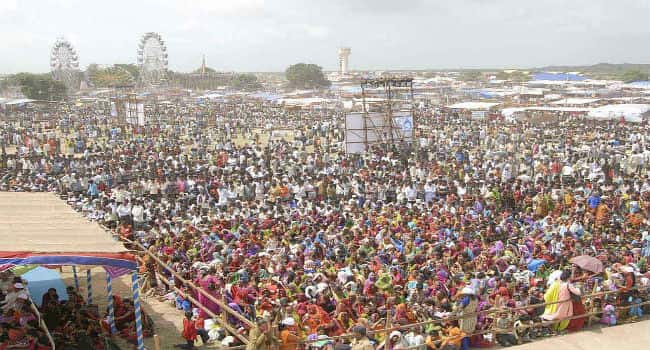
Surendranagar district is where the famous Tarnetar festival is held annually in Gujarat. This district is close to Rajkot and also to Thangadh city. The fair is held on the first week in September for 3 days. And it is speculated that the fair originated about 200 to 250 years ago and apparently is based on the story of Draupadi’s marriage. The fair is usually hosted near a beautiful temple called the Trinetreshwar Mahadev Temple. And a number of estimated tourists visiting this fair is around 100,000 people. The Tarnetar also signifies the folk dance form of Gujarat. It is also known for the age-old system of young men and women of the Maldhari tribe, as they choose their partners for marriage during this fair and they also perform the famous Raas and Hudo dance.
9- Tithal Beach Festival (October)
Gujarat is not only famous for religious and spiritual festivals but also for fun festivals. Tithal Beach festival is one festival, which is celebrated with immense enthusiasm and fun. It’s organized at Tithal Beach in the month of June/October. The beach is known for its scenic beauty and black sand. During the festival, Tithal beach hosts a huge entertainment program with music performances, food, and fun activities, especially for the younger generation.
10- Vautha Fair (November)
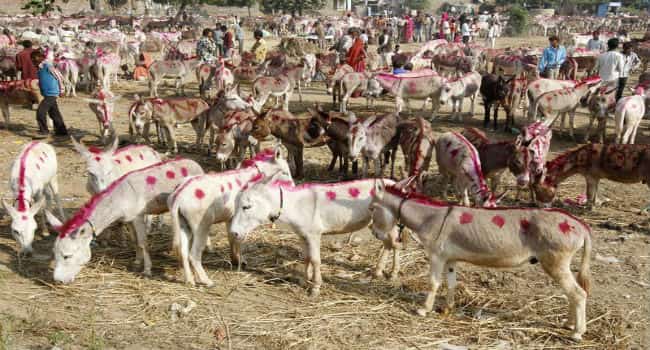
It’s a spectacular fair that is held every year at Vautha, where the rivers, Sabarmati and Vatrak meet. It’s considered to be one of the largest fairs in Gujarat. And according to legends, Kartikeya, the son of Lord Shiva had visited the site and is held during Kartik Purnima, the full moon night for 2 to 3 days. The pilgrims who visit Vautha include farmers, laborers, and tourists belonging to several castes and religions. It’s also one of the largest trade fairs in Gujarat.
11- Janmashtami
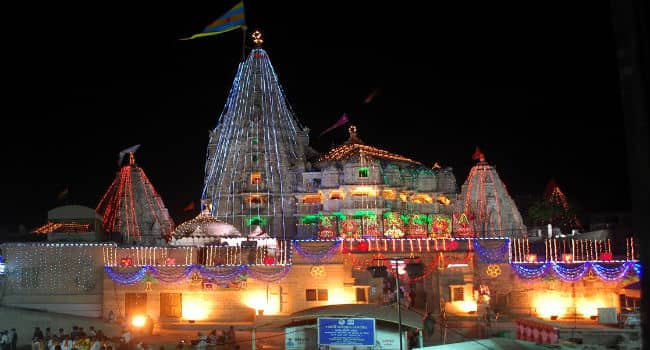
Dwarka which was historically the kingdom of Krishna is presently located inside the territories of the current state of Gujarat and this is why Krishna Janmashtami is such a big festival in Gujarat. All Vaishnav homes and other Hindus of Gujarat follow the festivities of Janmashtami with great reverence. All the celebration starts with the religious fast that happens on Saptami i.e. the 7th day which is followed by an all-night vigil that celebrates the birth of Lord Krishna and his shifting to Gokul by his father. At the exact hour of midnight, the Krishna idol is bathed in pure milk and reverently placed in a cradle to be worshipped.
The devotees break their fast with food that has been first offered to Krishna. There is a ceremony of Dahi Handi that is performed as it is the tradition to break the earthen pots which have been filled with buttermilk and mounted high up. The people of Gujarat form a human pyramid and the one person at the top gets the honor of breaking the pot. All the people who surround the pyramid keep throwing water at the group who form the pyramid. The Handi breaking ceremony is closely followed by delicious day-long feasts where friends, families, and relatives come together for celebrations. Sweets, butter products, and dairy items are generally made for this festival.
Rasa Lila is always performed on Janmashtami to pay tribute to the love story of Krishna and Radha. Every Gujarati performs the puja with a lot of reverence and joy. It is common for Janmashtami fairs to be held in various areas in Gujarat. Night-long celebrations are held in Dwarka, Krishna, and the temples of Dakor.
12- Modhera Dance Festival
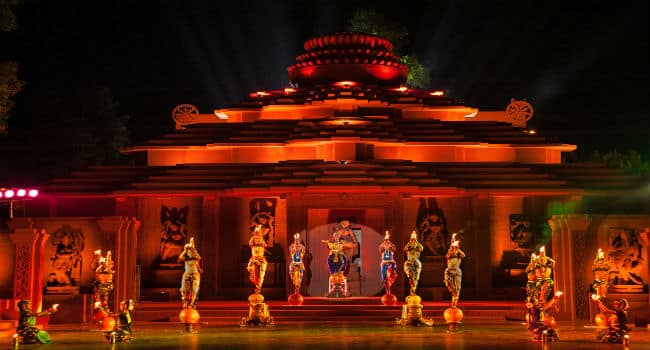
The Modhera Dance Festival is held for three days during the 3rd weekend of the month of January after the end of the festival of Uttarayan. The environment of the Sun Temple of Modhera is actually the venue and the primary host of the Modhera festival. The Modhera festival is located in the South-Western part of the district of Mehsana and is 25 km away from the town of Mehsana.
The dance festival Uttarardh or Modhera gets its name from the planetary configuration of the holy Sun. The Festival celebrates the pious rotation of the earth around the sun. Uttarayan also denotes the day when the Sun begins his journey towards the North and t signifies the end of winter and commencement of longer days. During the period of Uttarayan, the Sun travels from the Sagittarius constellation to Capricorn Constellation. The Modhera Dance Festival celebrates the art form of dance and is visited by artists, dancers, and celebrities from all over the globe. Artists and danseuses from every state come to this festival to showcase their skills. Culturally this festival is quite big and commands a lot of media glare.
13- International Kite Festival
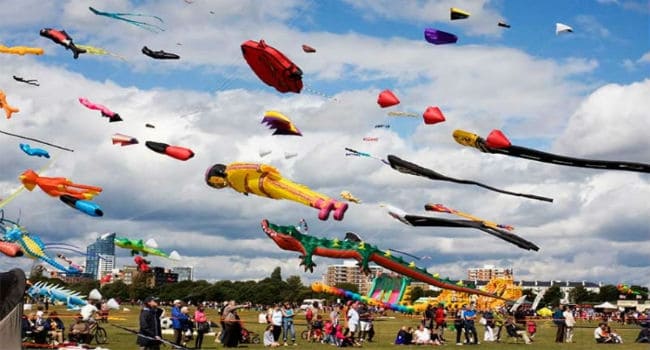
International Kite Festival Uttarayan or the International Kite Festival is one of the most amazing and well-known festivals in Gujarat. Every homeowner in Gujarat begins making kites months before the festival is held. The Kite Festival is believed to celebrate the transition of winter into summer as depicted by Indian Calendar. For Farmers, this is a sign the fruitful season is back and this day is also called Makar Sankranti (a very important Harvest Day). Many cities in Gujarat keep organizing competitions between their citizens and most people keep competing with each other to cut each other’s kites. Uttarayan or Kite Festival is so big in stature that it is declared a 2-day public holiday in the state. Local delicacies like Undhiyu (prepared from assorted vegetables, beans, and yams), sesame seed Vadas, and hot Jalebis.
The Guinness Book of World Records has mentioned the International Kite Festival because of the participation from 42 countries. The Kite Festival is celebrated in many Gujarat cities like Ahmedabad, Rajkot, Surat, and Vadodra. The most amazing place where to enjoy this festival is the Sardar Patel Stadium which can accommodate more than 54,000 people. In the center of Ahmedabad lies a bustling market called the market of kites or the Patang Bazaar. During the festival, the Patang Bazaar is open 24 hours a day with a brilliant cornucopia of buyers and sellers who keep negotiating wares. A Kite museum is located in the Paldi location of Ahmedabad and it’s very popular amongst tourists who come to see this festival.
14- Holi in Gujarat
Gujarat Holi Festival The whole state of Gujarat rings to the beat of folk songs like “Govinda Ala Re Matki Sambhal Brijbala” etc. the youth of Gujarat are very fond of the festival of Holi. The youngsters move around in small groups or Tolis and they drench each other in colored water and Gulaal. Homes stock up on butter and milk which is stored in earthen pots. Young boys try to steal butter from homes aping the mischievous antics of Lord Krishna. Breaking pots of buttermilk which are mounted high on town squares is also an important tradition. There are interesting prizes offered to people who manage to break the pots and they are crowned as Holi King. On the day before Holi, a big bonfire with blooms and fruit is lit and a blazing fire is brought on a torch to the temple. Offerings of raw mangoes, sugar toys, coconut pieces, and Khoya are offered to Holika and people smear each other with Tilak. Young virgins from Gujarat make images of the Gaun Goddess from the Holika ashes. The third day of festivals is called Dhuleti or the day of play of colors.
15. Diwali/ Deepavali
Diwali is one of the most prominent festivals in India and in Gujarat it is celebrated with some particular characteristics. Diwali occurs in the 2nd Lunar Paksha or Krishna Paksha in Ashwin month. In Gujarat, this month is called Also. People in Gujarat light lamps from the 11th day of Also Vad or Agyaras the people of Gujarat light lamps or Diyas to decorate their home well. It is known that this will protect their home from evil spirits. In Gujarat, there is a 5-day holiday given on account of Diwali till the day of Labh Pancham. Vaak Baras occurs on the 12th day of Also month and it is also known as Guru Dwadashi. Cows are worshipped on this day and new account books are opened. In Gujarat, men color themselves like tigers or Bagh, and the people of the village feast together.
Gujarat Diwali Festival Dhanteras occurs on the 13th day of the month of Aso and Gujarati communities worship Lakshmi Devi on this day. Gold ornaments, money, and diamonds are brought out for worship. Most Gujaratis believe that if they spend money on this day prosperity will come to their home. Kali Chaudas represents evil 14th day of Aso month. On this day Kali Mata who killed the evil Raktavija is worshipped.
Diwali is celebrated on the 15th day of Aso month and it is the day when people go to visit temples and pay homage to the Gods before wishing their friends and family Happy Diwali. All homes are decorated with Rangoli and Diya. People in Gujarat burst a lot of firecrackers and light and sound shows are organized in many places.
16- Dangs Durbar Fair
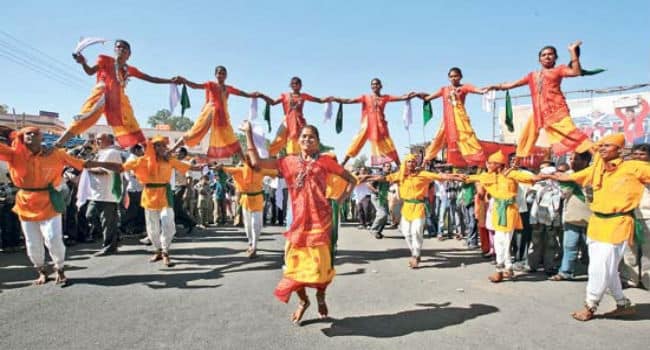
This fair is spearheaded by the tribes of the Dang district, who reside in areas of Satpura Hills and Ahwa. It is the perfect blend of the cultural superiority of the people. During the occasion, some authentic tribal instruments are played. Honors are bestowed upon tribal heads.
17- Shamlaji Fair
This three-week-long fair is also known as the Kartik Purnima Fair, and hence it’s celebrated in November (November is Kartik month, in the Hindu calendar). Gracias and Bhils are the major tribes that celebrate it. Nevertheless other tribes also enjoy.KalioBavji, a local deity is worshiped during the festival. The fair is organized at the Shamlaji Temple, on the banks of the Meshworiver. The fair is a bustling site for trade activities.
18- Ambaji Purnima Fair
This fair derives its name from the Ambaji temple, one of the Shakti Piths of Hindu mythology. The Bhadrapad Purnima is the auspicious day when devotees gather at Ambaji and this grand fair is held, in the month of September. It stretches for three days. Reciting religious scripts devoted to the goddess, along with performing Bhavai and Garba dance forms are prime events.
19- Mango Festival
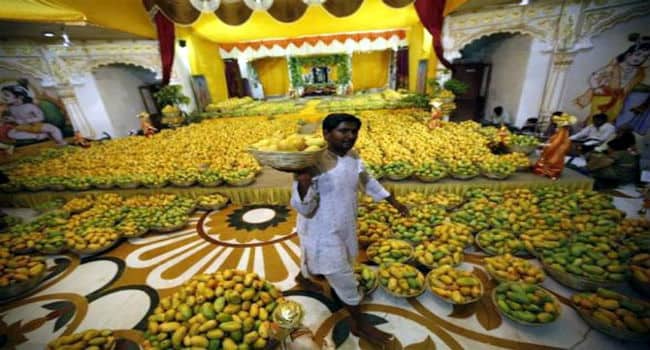
One of the most sought-after festivities of Gujarat is the Mango Festival. It is observed in Sasan Gir, Junagadh, extending to three days. Over 70-80 varieties of mango are exhibited here by farmers from across the nation.
20- Saputara Monsoon Festival
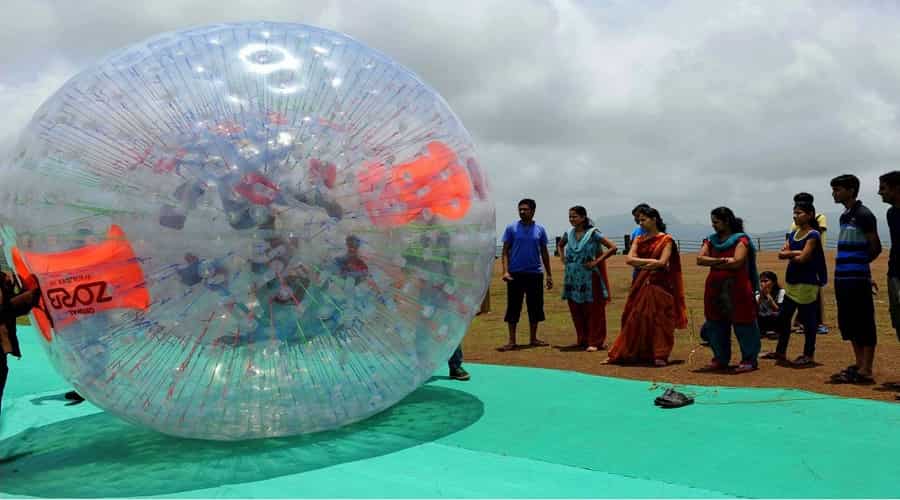
There is a Monsoon Festival organized by Gujarat Tourism in Saputara which is the only hill station in the state of Gujarat. The Monsoon Festival which lasts for a month-long is held for attracting tourists to the Dang District, this district bears a unique culture, environment, and locale. The beginning of this festival marks from 30th July to 30th August.
The location of Saputara is at the height of 873 m at the beginning of the Sahyadri hills of the Dang district which is not much touched by urbanization. The distance between Saputara from Surat is 170 to 180 kilometers. You can enjoy the cool weather in Saputara almost throughout the year and you can too please your eyes with the greenery of the environment. This place is dotted with streams, lakes, hills, and woodlands. You can live a beautiful surprise by visiting Saputara in summers and monsoons.
In monsoon, Saputara looks all wet under rains thick blanket. For adventure lovers, you can have the fun of fog and clouds spread over the hills. As this Monsoon Festival is for the first time, for the promotion of this there was a Road Show in Mumbai that was held on 1st July 2011. From the sources, it is brought to notice that though being for the first time it has managed to draw tourists from places like Maharashtra, Goa, Kerala, and many more. Even foreign tourists are taking interest in this festival.
There are many activities that will be organized at the Monsoon Festival including laser shows, water sports, food festivals, heritage walks, contests, and many more on the list. So come and be a part of such a stunning festival for the first time in Saputara, which will surely make you feel fresh and can make the essence of monsoon stronger, so what are you waiting for just jump on to the Monsoon Festival of Saputara.

